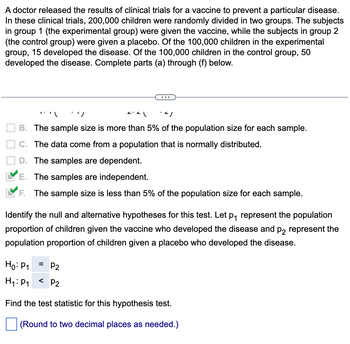A doctor released the results of clinical trials for a vaccine to prevent a particular disease. In these clinical trials, 200,000 children were randomly divided in two groups. The subjects in group 1 (the experimental group) were given the vaccine, while the subjects in group 2 (the control group) were given a placebo. Of the 100,000 children in the experimental group, 15 developed the disease. Of the 100,000 children in the control group, 50 developed the disease. Complete parts (a) through (f) below. (a) What type of experimental design is this? Completely randomized design Case-control Matched-pairs design O Randomized block design (b) What is the response variable? O A. The amount of the vaccine received O B. Whether the subject contracted the disease or not O C. Whether the subject was in group 1 or group 2 O D. Whether the vaccine prevented the disease or not
A doctor released the results of clinical trials for a vaccine to prevent a particular disease. In these clinical trials, 200,000 children were randomly divided in two groups. The subjects in group 1 (the experimental group) were given the vaccine, while the subjects in group 2 (the control group) were given a placebo. Of the 100,000 children in the experimental group, 15 developed the disease. Of the 100,000 children in the control group, 50 developed the disease. Complete parts (a) through (f) below. (a) What type of experimental design is this? Completely randomized design Case-control Matched-pairs design O Randomized block design (b) What is the response variable? O A. The amount of the vaccine received O B. Whether the subject contracted the disease or not O C. Whether the subject was in group 1 or group 2 O D. Whether the vaccine prevented the disease or not
MATLAB: An Introduction with Applications
6th Edition
ISBN:9781119256830
Author:Amos Gilat
Publisher:Amos Gilat
Chapter1: Starting With Matlab
Section: Chapter Questions
Problem 1P
Related questions
Question

Transcribed Image Text:A doctor released the results of clinical trials for a vaccine to prevent a particular disease. In these clinical trials, 200,000 children were randomly divided in two groups.
The subjects in group 1 (the experimental group) were given the vaccine, while the subjects in group 2 (the control group) were given a placebo. Of the 100,000
children in the experimental group, 15 developed the disease. Of the 100,000 children in the control group, 50 developed the disease. Complete parts (a) through (f)
below.
(a) What type of experimental design is this?
Completely randomized design
Case-control
Matched-pairs design
Randomized block design
(b) What is the response variable?
O A. The amount of the vaccine received
B. Whether the subject contracted the disease or not
C. Whether the subject was in group 1 or group 2
O D. Whether the vaccine prevented the disease or not
Expert Solution
This question has been solved!
Explore an expertly crafted, step-by-step solution for a thorough understanding of key concepts.
This is a popular solution!
Trending now
This is a popular solution!
Step by step
Solved in 2 steps

Follow-up Questions
Read through expert solutions to related follow-up questions below.
Follow-up Question
What would the test statistic and p-value be for this? Thanks!

Transcribed Image Text:A doctor released the results of clinical trials for a vaccine to prevent a particular disease.
In these clinical trials, 200,000 children were randomly divided in two groups. The subjects
in group 1 (the experimental group) were given the vaccine, while the subjects in group 2
(the control group) were given a placebo. Of the 100,000 children in the experimental
group, 15 developed the disease. Of the 100,000 children in the control group, 50
developed the disease. Complete parts (a) through (f) below.
"*"\ :')
-4)
B. The sample size is more than 5% of the population size for each sample.
C. The data come from a population that is normally distributed.
D. The samples are dependent.
E. The samples are independent.
F. The sample size is less than 5% of the population size for each sample.
<.<\
Identify the null and alternative hypotheses for this test. Let p₁ represent the population
proportion of children given the vaccine who developed the disease and p2 represent the
population proportion of children given a placebo who developed the disease.
Ho: P1
= P₂
H₁: P₁ < P2
Find the test statistic for this hypothesis test.
(Round to two decimal places as needed.)
Solution
Knowledge Booster
Learn more about
Need a deep-dive on the concept behind this application? Look no further. Learn more about this topic, statistics and related others by exploring similar questions and additional content below.Recommended textbooks for you

MATLAB: An Introduction with Applications
Statistics
ISBN:
9781119256830
Author:
Amos Gilat
Publisher:
John Wiley & Sons Inc

Probability and Statistics for Engineering and th…
Statistics
ISBN:
9781305251809
Author:
Jay L. Devore
Publisher:
Cengage Learning

Statistics for The Behavioral Sciences (MindTap C…
Statistics
ISBN:
9781305504912
Author:
Frederick J Gravetter, Larry B. Wallnau
Publisher:
Cengage Learning

MATLAB: An Introduction with Applications
Statistics
ISBN:
9781119256830
Author:
Amos Gilat
Publisher:
John Wiley & Sons Inc

Probability and Statistics for Engineering and th…
Statistics
ISBN:
9781305251809
Author:
Jay L. Devore
Publisher:
Cengage Learning

Statistics for The Behavioral Sciences (MindTap C…
Statistics
ISBN:
9781305504912
Author:
Frederick J Gravetter, Larry B. Wallnau
Publisher:
Cengage Learning

Elementary Statistics: Picturing the World (7th E…
Statistics
ISBN:
9780134683416
Author:
Ron Larson, Betsy Farber
Publisher:
PEARSON

The Basic Practice of Statistics
Statistics
ISBN:
9781319042578
Author:
David S. Moore, William I. Notz, Michael A. Fligner
Publisher:
W. H. Freeman

Introduction to the Practice of Statistics
Statistics
ISBN:
9781319013387
Author:
David S. Moore, George P. McCabe, Bruce A. Craig
Publisher:
W. H. Freeman